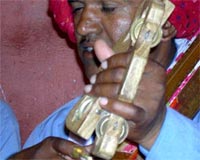KARTAL
Introduction
In India the word Kartal literally means rhythm of the hand which is made of wooden blocks with holes for the fingers and circular copper plates. Pairs of Kartals are played with both hands. Kartals usually accompany religious music in India played during the festivals and even near the holy places.Kartal is a distinctive instrument used in the Biraha singing by the Ahir community, it consists of two sets of two iron bars. Almost a foot long and tapered at both ends the players hold these loosely in both hands and they create a high-pitched clang when rapidly struck against each other.
Kartal in India is a common percussion instrument in the "ghan" vadya. The word "kartal" means "to make a clap." Rather, this implies a rhythm. The purpose of kartal is to produce a rhythm in the singing. The origin of side rhythms have been in found in the Vedic paintings through striking blocked wood with jingles together and small cymbals known as "manjira." In most of North India, Kartal instrument represents blocks of wood with jingles.

The karta also known as khartal is an ancient instrument which has been always a favourite for saints and seers. Even today kartal is being used in temples and gurdwaras. According to popular Musicians Kara means hand and tala means clapping, i.e., the instrument played by hands to keep rhythm in devotional songs, kirtana and dance. Despite being used for devotional music it has carved an important place for itself for the folk music in Punjab. The contemporary rural bhangra dancers sport the toombi or iktara in one hand and khartal in the other while dancing. Meera Bai attained the stage of salvation by singing devotional songs using the toombi in one hand and kartal in the other. This instrument even today in India accompanies bhajans, hymns, or mournful songs on sad occasions.
A pair of wooden castanets with little bells attached to them was the earliest form of the kartal. Kartal comprises two similar shaped wooden pieces and is 8 to 12 inches long and 2 to 3 inches wide. Small round brass pieces are affixed over these wooden pieces. One of the pieces has a space for the thumb and the other to hold four fingers. It is played by the same hand. Khartal or Kartal is an ancient instrument mainly used in devotional songs in India. It usually comes under the class of idiophones or self-sounding instruments that combine properties of vibrator and resonator.
How to play a Kartal
Kartal are a pair of wooden blocks or frames with small metal jingles mounted in them. They are simply beaten together to provide a rhythmic support to bhajans, kirtan, folk and other light music. The term kartal is also applied to wooden claves. Kartal are a pair of wooden blocks or frames with small metal jingles mounted in them.Places to learn to play a Kartal
Mr. S Kumar (Director, Head Office)3 Ka 7, Jawahar Nagar
Jaipur - 302004
Rajasthan. Tel. : 0091/(0) 94143 12872
Fax : 0091/(0) 141/2622098
Mobile : 0091/(0) 98291 53949
Email :[email protected]
Where to buy a Kartal
Mr. Kumar (CEO)Team India-shopping.net
A Unit of Sumanglam Sales Corporation (India)
Jaipur - 302004 Rajasthan (India)
E-mail: [email protected]
Website: www.india-shopping.net
AccuVis DBA WorldMusicalInstruments.com
931 W. 75th Street, Suite 137 - #128
Naperville, IL 60565
Phone: 866-488-4878
FAX: 866-316-9961
E-Mail: [email protected]


